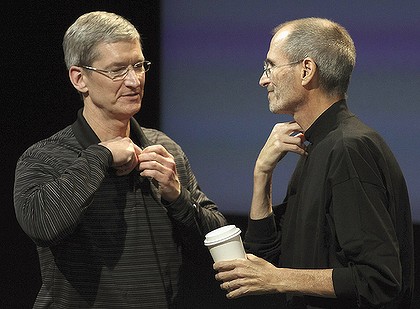How would you like to follow the world’s most successful technology entrepreneur? What would you do to keep your organization growing against the odds? How do you create a successful succession strategy when your CEO is terminally ill? These were just some of the challenges facing Tim Cook, CEO of Apple.
What can you learn from Steve Jobs and Tim Cook that will help you create an effective succession strategy?
How did Tim Cook become one of the world most effective CEOs while working with the world’s most dominant CEO, Steve Jobs? I think we can safely say that Tim Cook is an extraordinary CEO.
I bet you’re thinking to yourself, “Hey, if someone turned over Apple to me, I would make sure it was still going strong.” Having spent the past 30 years working on many successful succession strategies, I’m willing to bet most of my stock portfolio that you would struggle to accomplish what Tim Cook has done so well. I believe we are at the next great technology boom. I believe that he will help change the way we work with people and technology.
There were three key elements to Apple’s succession strategy. You won’t find them in many business books, but I hope to share them with you, the leaders of your business. If you begin implementing these key elements into your business succession strategy, I feel certain your business will keep growing for future generations.
The first key element is hiring a successor who knows where your business is going and how to get there. Tim Cook was as great at the inside things as Steve was to marketing. When you talk to people around Apple you realize how great Tim is at making sure things get done. He did this by combining an unusual attention to detail while managing the bigger picture within the organization. A large part of Apple’s long term success will be attributed to how good they are at operations and supply chain integration. As we move into the next generation of technology, we will see how tech empowers our everyday lives.
Apple is a great marketing organization, but if the product isn’t on time and on budget, the organization would have alienated many of their most loyal fans. Tim built an organization that could meet their operational challenges head on. His own inner circle is selected by Tim based on a proven performance record. He has invested significant time understanding his team members’ strengths and knows how to get great performance out of his organization. Like Steve, he understands how to motivate and inspire his people to take their performance to a higher level. The men couldn’t be more different in how they inspired others, but it’s difficult to challenge their successful shared results.
It is critical that today’s CEOs understand their markets and where they are going. In many cases, the best strategy is to work to the leaders’ strengths and match them with the organization’s ability to change the markets to match their teams’ strengths. Tim Cook understood both what was happening currently, but deciding where the bigger trends are going to lead in the future.
Later this week, we talk about two other keys to leading a high performance organization and how great succession planning supports future growth and opportunities inside and outside your organization. See you Thursday.




Be the first to comment on "What Can CEOs Learn from Apple’s Succession Strategy?"